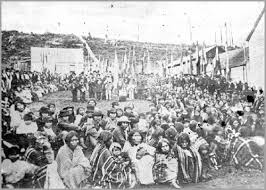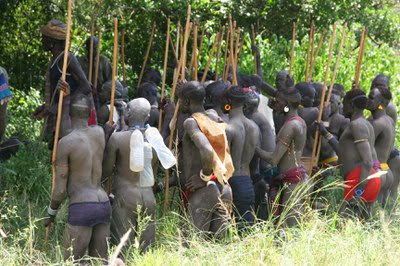AGE & SEX:
- all cultures make distinctions based on age & sex (as we learned when we spoke about division of labor)
- SEX:
- degree of sexual segregation
- living arrangements
- division of labor
- menstruation taboos
- symbolic segregation
- rigidity of sex roles
- hunters and gatherers (flexible)
- horticulturalists (rigid)
- institutionalized homosexuality & sexual ambuguity
- symbolic value placed on sex roles & activities
- which carry greater prestige, men's or women's roles?
• Iroquois example• matrilineal society, matrilocal • women were in charge of the economy, of the house, of subsistence, of inheritance • men in charge of hunting, warring, raiding, trading, diplomacy • when men were in the village, they lived with and slept with the women • men and women were separate-but-equal • low incidence of intra-group rate• but high incidence of rape outside of group• Mundurucu example (Brazilian Amazon) • men lived separately from the women• men and boys older than 13 live together • all females and all children under 13 live together • women's buildings are grouped around the men's• separation validated by mythic belief in power struggle over the sacred trumpets (represents the generative power of women) which women lost because they were not able to hunt, which was necessary to satisfy the trumpet spirits' desire for meat• the trumpet is kept in the men's lodge • if a woman enters to look at it, she may be gang-raped• great hostility and fear between men and women• Haviland suggests that the Mundurucu are like people in American society • how is this parallel supportable?• rule by men replacing matriarchal rule was held by many 19th century scholars • difference: women in Mundurucu society have had more control over their economic life than women in traditional European (and USA) societies• this is slowly changing now IN WESTERN SOCIETY, but not even to the level that Mundurucu women enjoy!• how valid is it?- Nonwestern culture
- plays a significant role and is more carefully delineated
- transition through riual from one age (stage) to another
- teaches needed skills
- economic and subsistence activities are organized around them
- AGE GRADES & AGE SETS
- age grades are categories/stages of people based on age
- every individual passes through a series of such categories in the course of a lifetime
- membership is automatic and may be accomplished individually or as a group
- ritual usually accompanies transition from one stage to another
- age sets groupings of persons initiated into age grades at the same time
- move through a series of categories together
• Example of an age set society: the Tiriki of East Africa: Kenya
• the members stay with the same group of people through their lifetimes • the age sets are divided into people who fall into 15 year periods • sort of similar to our idea of generations• only as a comparison, as a basis for thinking about them • difference: the people in a trueage set are a community, do things together, share similar symbols, eat, drink, act, do all things together, appropriate to their age (whatever that may be at whatever stage in life they are at)• only one of the 7 age sets in this society is open at a time • four (4) age grades exist in conjunction with these age sets• the people in age sets move into and out of age grades in the same 15 year cycle that exists for the age sets• the 4 age grades of the Tiriki of East Africa• Warrior age grade• once the guardians of the people • since colonized, they now leave the community to study or work abroad• Elder Warriors • administrators • acted as negotiators for their community with other communities • learned skills for the later age grades• Judicial Elders • served as the local judges, judging local disputes• Ritual Elders • served over ritual functions; served as the functional equivalents of priests • credited as having special access to magic, to spirits, to ancestorsExample:
As amongst other East African herders, men are formed into named ‘age sets’, and pass through a number of ‘age grades’ during the course of their lives. Married women have the same age grade status as their husbands. By becoming a member of an age set (teny) a man achieves full social adulthood (hirimo), although this may happen long after he has reached physical maturity. Members of the most recent set to be formed occupy the grade of rora, which may be translated as ‘junior elders’. When a new set is formed, the previous rora become bara, or ‘senior elders’ and the previous bara become karui, or ‘retired elders’.
It is the bara of a local community who are expected to play the leading role in reaching decisions about matters of public concern and to be most active in public meetings. But some bara are more politically ambitious than others, and these will be more active in public life. Some are also more highly regarded than others for their statesmanlike qualities and oratorical skills, although none have the right to make decisions on behalf of the community as a whole.
The rora are often described as the equivalent of the Ethiopian police force or army. Their job is to assist the bara in ensuring the safety of people and of the herds and the smooth running of internal community relations. Depending on the interval between the formation of successive sets, however, this ideal division of tasks may not reflect the social reality for many men. The most recent set, known as Geleba (the Mursi name for the Dassanetch, who live in the lower basin of the Omo), was formed in 1991. This was thirty years after the formation of the previous set, Benna (Stones), which now occupies the bara grade. Because the Geleba set has an age span of thirty years (its youngest members are now around 30 and its oldest members around 60), some senior members of the set, although officially rora, play a role in public decision making which is indistinguishable from that which, according to the ideal, is expected of bara.
Each local group (bhuran) holds its own age set formation ceremony (nitha) in the same year, and according to a strict order of precedence. This begins with the southern group, Ariholi, followed by Gongulobibi and then Dola. Ariholi, which is known as the ‘stomach’ (kiango) of the country, has priority because it was the first part of current Mursi territory to be settled. In 1991 the Ariholi ceremony was held at Kurum, on the left bank of the Omo, and was organized and presided over by the late Ulijeholi Garana.
- COMMON INTEREST ASSOCIATIONS
- associations not based on age, kinship, sex, marriage or territory
- Voluntary associations
- examples:
- recreation
- friendship
- government
- expressions of rank
- economic interest
- social function
- benevolent sociaties
- ritual groups
- hertiage
- are highly elaborated in western and industrial societies all though they exist in all cultures.
- serve important functions in cultures undergoing rapid change
- assume roles and functions formally held by kinship or age groups
- "urban associations"
Social Organization: How human beings relate to one another and achieve individual power through group actions and decisions.
STATUS: the amount of power and prestige you have access to in any society (indicated through)
- verbal evaluation
- symbolic evaluation
- occupation
- wealth
- dress
- recreation
- residential location
- lifestyle
- stature/health/physical marking
- patterns of association
ROLE: the job that you perform as a member of your culture.
*status may determine role and/or role may determine status depending on the social organization.
LEVELS OF SOCIAL ORGANIZATION
- social systems in which as many valued positions exist as there are persons
- where everyone has equal status, within the distinctions always made based on age and sex
- hunters and gatherers
- low level horticulturalists (some), mixed subsistence
- Social systems in which there are status differences, but these do not allow differential access to the accumulation of wealth, just prestige.
- Lineal kin-based systems where lineages perform different functions
- horticultural (plant focused)
- Stratified Societies
- societies in which two or more groups of people are ranked on a hierarchy (high and low status) relative to one another
- they do not share equally in the basic resources that support life
- They have greater access to power and prestige
- Advanced horticultural societies, Agricultural societies, Industrial agriculture
- two types
- CLASS
- hierarchically arranged strata
- born into a class, but mobility between strata possible although it may be difficult to achieve (up or down)
- factors: birth, education, wealth, occupation, education, etc.
- status is "achieved" & mutable (changeable)
- status and role influence each other
- CASTE
- hierarchically arranged strata
- you are born into a caste and there is no mobility between strata
- status is "ascribed" & immutable
- status DETERMINES role
- diet
- language
- occupation
- dress
- marriage arrangements
- religious observance
- etc
- examples:
- caste system of India (Hindu)
- Apartheid South Africa (Black/white)
What's the caste system?
The Indian caste system is a process of placing people in occupational groups. It has pervaded several aspects of Indian society for centuries. Rooted in religion and based on a division of labor, the caste system, among other things, dictates the type of occupations a person can pursue and the social interactions that she may have.
- Castes are an aspect of Hindu religion. Other religions in India do not follow this system.
- Castes are ranked in hierarchical order (originally, the system wasn't to have a hierarchy based on occupation or birth but purely on personality; this has been skewed somehow over time), which determines the behavior of one member of society over another.
- Even in a modern business setting, where caste isn't openly acknowledged, there may be subtle observances of village or family-style ranking. For instance, a young official may address a senior person, not necessarily his superior, as chachaji, a respectful term for a paternal uncle.
How it's structured
India's caste system has four main classes (also called varnas) based originally on personality, profession, and birth. In descending order, the classes are as follows:
- Brahmana (now more commonly spelled Brahmin): Consist of those engaged in scriptural education and teaching, essential for the continuation of knowledge.
- Kshatriya: Take on all forms of public service, including administration, maintenance of law and order, and defense.
- Vaishya: Engage in commercial activity as businessmen.
- Shudra: Work as semi-skilled and unskilled laborers.
-------------------------------------------
- Untouchables: exist outside the caste system (Taboo & polluting)
In this rigid system, the lower castes were prevented from aspiring to climb higher, and, therefore, economic progress was restricted.
- Mahatma Gandhi, the father of modern India, made the lower castes and untouchables a fifth, lowly class with the name Harijan, or "children of God."
- You see many references to SC and ST in India, in newspapers, government notifications, and so on. These initials refer to Scheduled Castes and Scheduled Tribes —scheduled is what Harijan is translated into today.
- The government is sensitive about reserving seats in colleges and job opportunities for them. But the government has legislation to make up for the past suppression and oppression of the lower castes.
How it works
- Castes still rarely intermarry and are definitely not changeable.
- In urban India, though, people of all castes meet socially or for business.
- Discriminating against anyone because of their caste for things like club memberships and so on is against the law.
- Though caste and community are facts of Indian life, foreigners are not expected to behave differently toward any caste.









